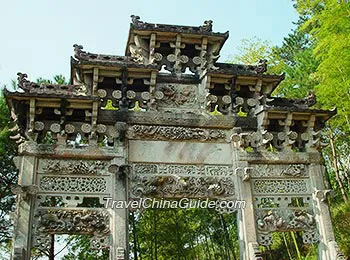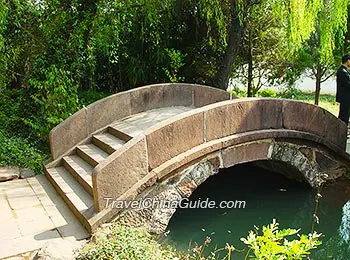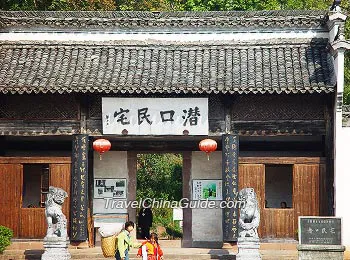Located 27km (17 miles) north of Tunxi District in Huangshan City of Anhui Province, the Qiankou Residence is an ancient architecture complex in the style of the Ming (1368 - 1644) and Qing (1644 - 1911) dynasties. It is also widely known as Zixia Mountain Villa because it lies at the foot of Mt. Zixia in Qiankou Town, which is about 60km (37 miles) from the
Huangshan Mountain.
One architectural expert acclaimed that to visit imperial palaces you should go to Beijing; whereas to see old folk residences, you should go to Qiankou.
In the 1980s, in order to protect the old residences, the government disassembled the most valuable old buildings from the Ming Dynasty in the neighboring area and then reassembled them in Qiankou in accordance with their original structures and appearances. Then in 1998, ten residences of the Qing Dynasty were selected and were also moved there. Thus, the unique Qiankou Residence was formed. With 24 ancient buildings, it is now a museum of civilian residences.
Qiankou Residence consists of two sections, namely, the Qing Garden and the Ming Garden.
Qing Garden of Qiankou Residence
The Qing Garden has eleven structures, including houses, ancestral temples, archways, pavilions and bridges, which are arranged along a circular road. Among these buildings, Gengli Hall, once a villa of governmental officials, is the biggest one. All of the building have magnificent architecture and are decorated with elaborate carvings. Over 20 TV series have been shot here to take advantage of the unique old-fashioned buildings and tranquil life style.
Ming Garden of Qiankou Residence
Walk across the Yinxiu Bridge over a pond and you will reach the Ming Garden. Located on a hill to the north of the Qing Garden, the Ming Garden is the highlight of the Qiankou Residence. Thirteen buildings are located there.
Yinxiu Bridge
Yinxiu Bridge, a single-span arch bridge, once linked a nunnery and the bustling village, thus it was regarded as a boundary between the Buddhist world and the secular world.
 | | Stone Archway | |  | | Yinxiu Stone Bridge | |
Fang Family's Stone Archway
The first structure you will encounter is the Fang Family's Stone Archway. Interestingly there is no inscription on the archway. Instead, there is a horrible ghost stepping on a dou, a measurement instrument for grain. The whole image implies the Chinese character Kui (魁), which means obtaining first place in the imperial examination. On the other side of the archway is a pattern of laurels. From those images, visitors can tell the big hopes the Fang Family had for their offspring.
Shanhua Pavilion
Climbing up a step, you will see the Shanhua Pavilion, sponsored by merchants, where visitors can have a short rest and continue their journey.
Leshan Hall
Then you will reach Leshan Hall, also called Maodie Hall. It used to be a gathering and entertainment place for the old in their eighties, but now it functions as an exhibition hall with paintings and calligraphies on display.
Cao Archway
Northeast of Leshan Hall is the Cao Archway, that was once a clan hall. Now only a gate and two corridors remain. From the Cao Archway, visitors have a panoramic view of Qiankou Town. Si Jian Di in the vicinity is also an ancestral hall. There are also six old mansions, each of which is unique.
How to get to Qiankou Residence
Take a bus from Huangshan Bus Station to Qiankou and then take a taxi to the residence.
| Entrance Fee | Free |
| Opening Hours | 8:00 – 16:30
Closed after 12:00 on 12th and 26th of every month. |
| Recommended Time for a Visit | 2h |

Nearby attractions:
 Chengkan Village
Chengkan Village Tangmo Ancient Village
Tangmo Ancient Village Tangyue Memorial Archway
Tangyue Memorial Archway
- Last updated on Sep. 01, 2025 by Demi Li -


